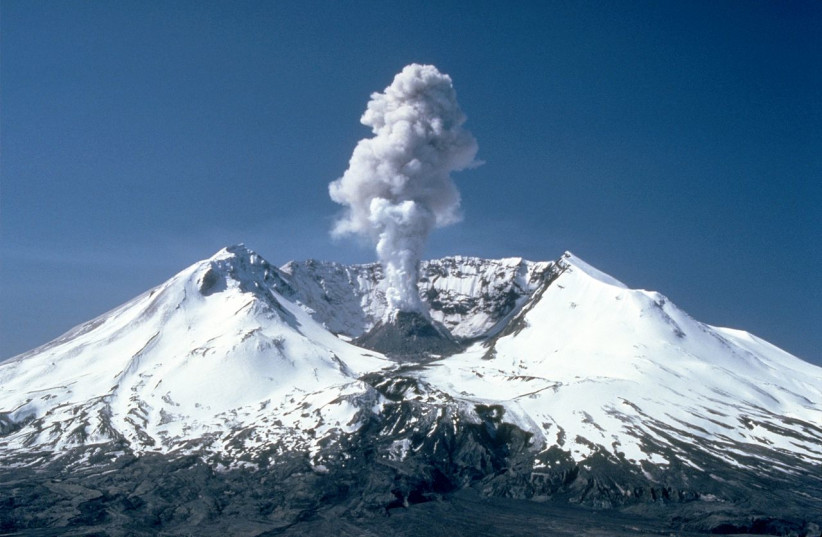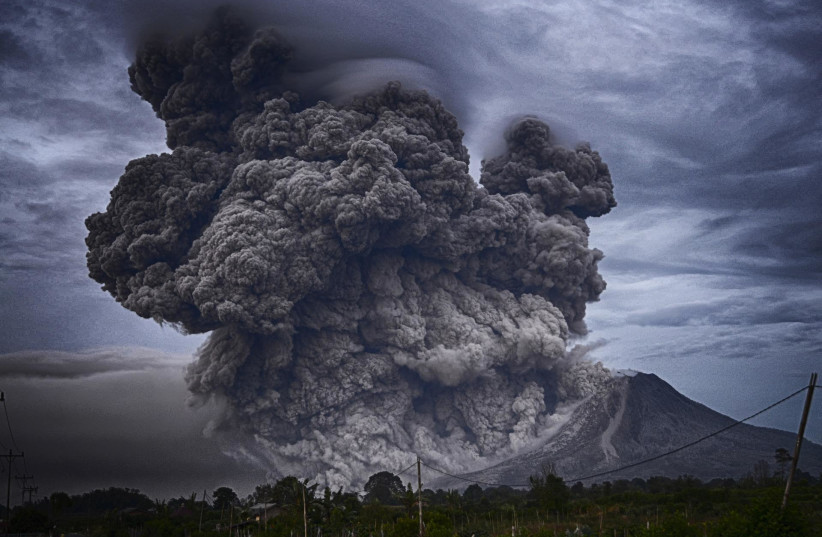Major volcanic eruptions have the potential to cause major damage to the world, and while the chances of such a catastrophic eruption aren't exactly the highest, we are not prepared for the devastation if it should happen, as experts have noted in an article published in Nature.
What is a volcano and how many volcanoes are there?
A volcano is a rupture in a planet's crust that is connected to the magma chamber. This connection allows volcanic ash, gases and lava to escape.
The typical image of a volcano in popular culture is of a large mountain, capped by a hole on the top from where lava and ash erupt.
Volcanoes are widespread throughout the world and can essentially be found in nearly region, even on Antarctica.

According to the US Geological Survey (USGS), there may be approximately 1,350 active volcanoes scattered throughout the world, 161 of them being in the US - the most famous of which are the volcanoes of Hawaii and Mount St. Helens in Washington.
Additionally, volcanoes are thought to exist underwater, though the exact number is unknown.
<br>What do volcanoes do and how dangerous is a volcanic eruption?
Volcanoes have played a role in numerous aspects of the planet's history.
One of the most famous incidents is the eruption of Mount Vesuvius in Italy, which resulted in the destruction of Roman localities like Pompeii and Herculaneum.
This is a good example of the sheer level of destruction a volcanic eruption can cause.
According to researchers, Vesuvius's eruption released 100,000 times more energy than the nuclear bombs dropped on Japan's cities Hiroshima and Nagasaki at the end of World War II and blasted an estimated 1.5 million tons per second of hot volcanic ash, molten rock and more.
While the ash killed many of the locals by covering and smothering them, many others faced different fates: Their skulls literally exploding, the heat boiling their blood or their brains turning to glass.
Vesuvius is just one example of such an eruption. And as bad as it may have been, many have been much worse.
The two deadliest eruptions in recorded history both took place in Indonesia in the 1800s. The second deadliest was the 1883 eruption of Krakatoa, which destroyed most of its island and surrounding archipelago, killed over 36,000 people and was felt thousands of kilometers away and heard worldwide.
The deadliest was the 1815 Mount Tambora eruption, which may have killed over 250,000 people.
But the modern era has other dangers to consider.

Volcanic eruptions in the modern day
The most recent catastrophic volcanic eruption was Hunga Tonga–Hunga Ha'apai eruption in Tonga, which climaxed on January 15, 2022. Its death toll was small, but the eruption is thought to be the strongest since Krakatoa. Its eruption caused tsunamis that hit the Pacific islands and the coasts of North and South America, Russia, New Zealand and Japan.
This and the resulting damages illustrate the real danger of a modern-day volcanic eruption: Economic devastation.
The researchers noted that the eruption significantly hit Tonga's economy and broke undersea communication cables, but the eruption peak only lasted 11 hours, preventing more ash and gas release.
Had this happened, it would have devastated densely populated areas and could have caused a severe problem for the global supply chain.
The fact that this didn't happen is what made the two researchers behind this article, Michael Cassidy and Lara Mani from the University of Cambridge's Centre for the Study of Existential Risk (CSER), describe it as a "near miss."
Specifically, the two compared it to an asteroid impact.
Asteroid impacts have the potential to be absolutely devastating, almost on the level of a global apocalypse. They are easily one of the most dangerous possible natural disasters that could occur. As such, there has been a major uptake in research in finding ways to protect the Earth from asteroid impacts, with NASA's Double Asteroid Redirection Test (DART) Mission currently being the most promising of these efforts.
But despite how many asteroids there are and how many regularly pass the Earth, the odds of such a cataclysmic collision occurring are relatively low.
But what about a giant volcanic eruption, such as one that could be anywhere from 10 to 100 times more powerful than what happened in Tonga? These magnitude 7 eruptions would be very dangerous, and the researchers compare them to the consequences of a 1-kilometer-wide asteroid impacting Earth.
When will the next giant volcanic eruption happen?
Many believe the odds of this happening are low. But while they aren't necessarily high, they are far higher than most realize, and hundreds of times higher than a catastrophic asteroid impact.
Further, NASA has calculated that the Earth is free of risk of a serious asteroid collision within this century. But as the researchers note, there is a 1 in 6 chance of a giant volcanic eruption in this century.
<br>How can a giant volcanic eruption devastate the world?
Aside from the immediate fatalities, the eruption can devastate the world's economy and climate cannot be understated.
A good comparison would be the last recorded magnitude 7 eruption in Tambora.
While the death toll was severe, it impacted the entire world.
The eruption launched huge amounts of volcanic ash, water and sulfuric acid into the atmosphere, obscuring the Sun and repelling some solar radiation.
This caused a phenomenon known as a volcanic winter, a major climate shift that can alter temperatures.
The Tambora eruption's volcanic winter hit hard in 1816, which has become known as the Year Without a Summer.
Temperatures dropped worldwide and climate and weather changes were felt everywhere. But Europe and North America were arguably the most severely hit, with lakes and rivers being frozen over during July and August. Crop damage was rampant, harvests ruined and food shortages widespread. Food prices skyrocketed and violent riots erupted. Malnourishment soon became a severe issue, facilitating disease epidemics that killed tens of thousands.
Could it get worse?
The world is already experiencing severe food shortages and rising prices, though these were largely caused by inflation and the Ukraine-Russia War. However, incidents like this, the COVID-19 pandemic and the blocking of the Suez Canal serve to underscore just how fragile the global supply chain is.
The global population has spiked eight times over since 1816 and global dependency on trade for food and energy, along with other resources, is arguably greater than ever.
That isn't the only way the world is different now. The effects of manmade climate change have been felt worldwide and are only continuing to worsen. In fact, global warming might be seen by some as something that either could counteract a volcanic winter or as something that a volcanic winter could solve.
But that doesn't change the fact that a massive abrupt shift in the climate would be horrifically devastating. It is a far more realistic crisis than something like an asteroid impact but also one we are vastly unprepared for. And that is something the researchers stress the need to fix.
<br>How can we prepare for a giant volcanic eruption?
The researchers argue a few tings that could be done. While efforts to monitor volcanoes do exist, more funds need to be invested in researching risks, identifying potentially active volcanoes and mapping out where these large eruptions would happen.
Efforts will also need to be done to see where these areas overlap with major trade routes to improve the transportation of needed resources like food and fuel.
Monitoring efforts would also need to be done to better research advanced warning systems, either through ground-based monitoring or through satellites, though that would also require improvements in satellite technology.
Specifically, however, a satellite specifically dedicated to volcano observation would be a great step forward.
Efforts should also be made to monitor the fallout of an eruption and find ways to better alert locals about what to do as it happens through SMS.
In particular, this community education and awareness, especially in vulnerable regions, can be a literal lifesaver. This was the case in 2021 during a volcanic eruption in the Caribbean island of St. Vincent, where one such effort in community education and awareness led to over 16,000 people being evacuated and no one dying.
But work should also be done to mitigate the climate damage. Specifically, if a volcanic eruption causes a volcanic winter, research should be done into developing methods to get rid of it.
Another potentially even more outrageous idea is to research moderating eruptions, something researchers are currently trying to do, as the researchers note.
This is something that will be very difficult, and the researchers note that many will call it inconceivable. However, they also note that the same was said about deflecting asteroids, and yet NASA is trying to do exactly that.
But all of this requires an investment of both funds and interest before it's too late.
